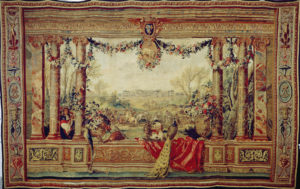By Garrett Swanson
Title: The Months or The Royal Houses: April (Versailles)
Artist: Designed by Charles Le Brun (French, Paris 1619-1690 Paris) and workshop
Date: Last quarter of the 17th century
Medium: Wool, silk, metal thread (haute lisse)
Dimensions: 13 ft. 1.5 in. x 21 ft. 3 7/8 in.
Mobilier National, Paris, GMTT 108/4
On the series of evocative landscapes set in the rich context of royal properties and woven by the Manufacture Royale des Gobelins in Paris, also known as The Months or The Royal Houses, little can be said with certainly about its artistic collaborators. The project’s supervisor, Charles Le Brun, likely devised the series’ distinct, compositional framework as evinced by a 1691 inventory that documents a model for the Versailles cartoon: “une esquisse peinte par M. Lebrun représentant le mois d’Avril.“ [i] In spite of scarce and complicated documentation pertaining to the project, M. Maurice Fenaille, the great historian of the Gobelins, defined The Royal Houses, along with its companion project, The History of the King, as “un ensemble qui permet d’apprécier le travail considérable accompli en quelques années par Le Brun et ses collaborateurs.”[ii] The first weaving commenced in 1668. By August 16, 1683, all twelve were recorded in the Garde-meuble de la couronne. Unfortunately, the order in which the tapestries were completed is not known.
For the month of April, Louis XIV appears in front of Versailles, promenading towards the chateau. As a series, The Royal Houses draws upon a long tradition of depicting the months of the year in combination with signs of the zodiac above, and below, scenes of the hunt. While the present example illustrates Louis XIV engaged in courtly ritual, other months of the year show him occupied by a hunt, one of his favorite pastimes. Commingling ceremonial pomp with the pleasures of a forest chase, these lively scenes facilitate a dialogue between cultivated nature and the house itself, not only as an appendage to the royal estate but as a celebration of Bourbon patrimony.
A well-dressed figure – perhaps a symbolic reference to king himself – and a young child (the dauphin?) lean against the ornamental balustrade enclosing the stage-like space. The richly veined pilasters at either end of this portico meticulously imitate a prized variety of French marble from the Sarrancolin-Ilhet quarry in the Hautes-Pyrénées. First discovered in the 1560s and admired for its resemblance to precious stones (notably agate), this marble was quarried for use as architectural ornament for the Ambassador’s Staircase and the Salon d’Hercule at Versailles. By 1689, these treasured quarries were reserved exclusively for the king’s use, thus reaffirming the place of this decorative stone in material expressions of royal power.
Enormous silver vessels, musical instruments, and imported textiles offer evidence of Louis XIV’s wealth as well as his commitment to cultural programs and international commerce; even colorful birds from the Versailles menagerie make an appearance. For instance, the silver vessel on the right corresponds with an entry in the royal inventories as the work of Alexis I Loir (1640-1713), orfèvre du roi at the Gobelins, who, along with other smiths, executed Le Brun’s designs for the king’s silver furnishings. Each of these components visually expresses the king’s magnificence.
Accents of festooned flowers often decorated events of the 1660s and 1670s. Their effusive presence at court affirmed the importance of cultivating the king’s image with the ‘fruits’ of his domain. As such, flowers were utilized in staging of fêtes, ballets, operas, and other ephemeral events performed for the crown, their multiplicity of form, scent, and color contributing to an idyllic and sumptuous atmosphere.[iii] Simultaneously aligned with seasonal changes, the profusion of floral and vegetal garlands in The Royal Houses also situates temporary spectacle—les menus plaisirs—in the context of the king’s self-proclaimed cosmology.
[i] Jules Guiffrey, “Les manufactures parisiennes de tapisseries au XVIIe siècle. Hôpital de la Trinite—Grande galerie du Louvre—Savonnerie—Faubourg Saint-Marcel—Faubourg Saint-Germain—Gobelins.” Mémoires de la Société de l’histoire de Paris et de l’Ile-de-France 19 (1892), 198.
[ii] Maurice Fenaille, Etat General des Tapisseries de la Manufacture des Gobelins, 1600-1900, vol. 2 (Paris, 1903-1923), 99.
[iii] For more on the political and symbolic uses of flowers during the reign of Louis XIV, see Elizabeth Hyde, Cultivated Power: Flowers, Culture, and Politics in the Reign of Louis XIV (Philadelphia: University of Pennsylvania Press, 2005).
